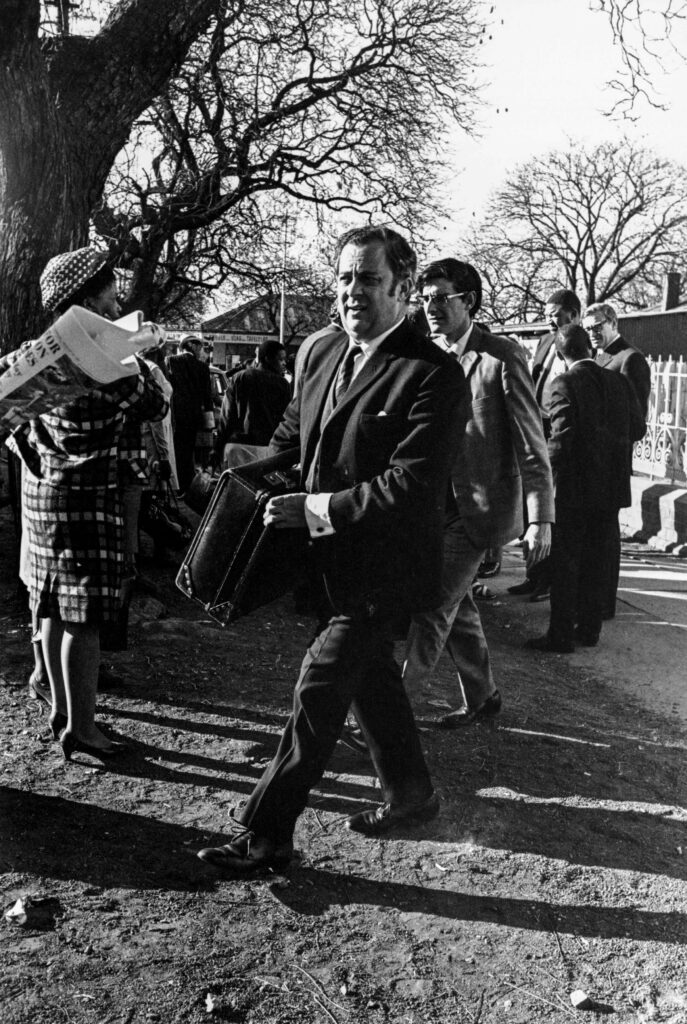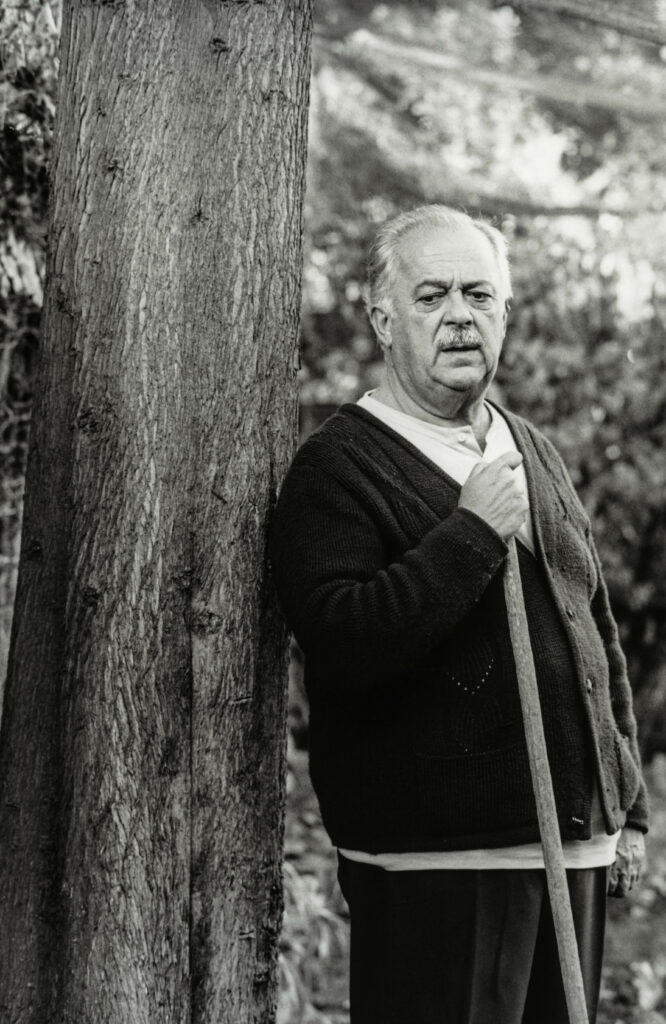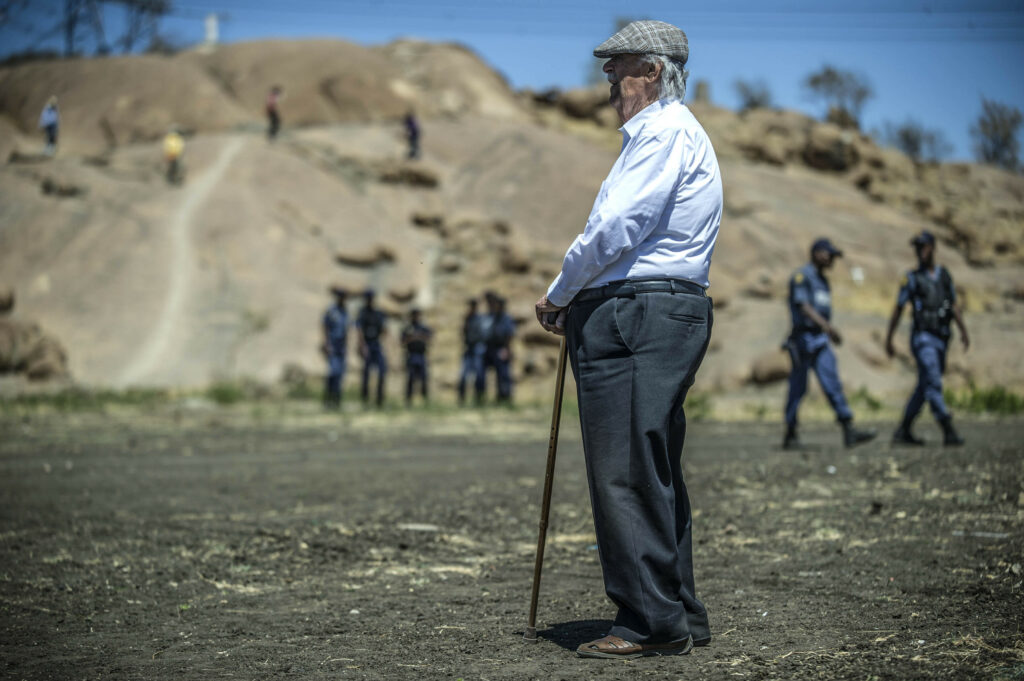Who will watch over us now?: George Bizos and Sydney Kentridge, leader of the defence team in the Braam Fischer trial in 1966.
George Bizos: Lawyer. Friend. Fighter. Human rights activist for a lifetime.
He was a junior member of the defence team in the 1963 Rivonia Trial, where Nelson Mandela, Walter Sisulu, Govan Mbeki, Raymond Mhlaba, Ahmed Kathrada, Lionel Bernstein, James Kantor, Dennis Goldberg, Elias Motsoaledi and Andrew Mlangeni faced the death penalty.
It was Bizos who led the inquests into the deaths of Steve Biko and Neil Aggett in detention.
He was counsel for Winnie Mandela and defended Albertina Sisulu, Barbara Hogan and the many other women who defied and opposed apartheid.
Bizos represented the families of Biko and Chris Hani during the Truth and Reconciliation Commission (TRC).
 Bizos and Johanna Ramotse (above), the wife of Sello Benjamin Ramotse. The human rights lawyer defended Ramotse in two trials. Photographer BAHA/Africamediaonline.
Bizos and Johanna Ramotse (above), the wife of Sello Benjamin Ramotse. The human rights lawyer defended Ramotse in two trials. Photographer BAHA/Africamediaonline.He also led the team to oppose applications for amnesty by the murderers of Matthew Goniwe, Fort Calata, Sparrow Mkhonto, Sicelo Mhlauli and Ruth First.
In 2004, Bizos was the defence lawyer at another treason trial, this time representing Morgan Tsvangirai, the leader of the party opposing Zimbabwe president Robert Mugabe.
At the Marikana inquiry, Bizos represented the Human Rights Commission and the families of mineworkers who had been killed.
It’s a prolific history of work and those who came to know him through it describe him as a legend they remember fondly. Bizos was an incredibly generous person.
Despite his relentless legal side, he never owned a cellphone and spent at least 30 minutes in his vegetable garden every day.
When former chief justice Ismail Mahomed joined the Johannesburg Bar, he could not keep chambers because of apartheid. Bizos intervened.
“George and Arthur Chaskalson allowed Ismail to squat in their chambers, to make sure that he could work. That was his generosity. Even in a time that was completely inhuman, he did what he could to make sure Ismail was able to practice, that his dignity was not impugned,” said TRC commissioner Yasmin Sooka
She recalls Bizos as a master storyteller. “He loved to tell stories of Greek mythology and related them to challenges we faced and the situations that we found ourselves in. I don’t know anybody who was that sort of raconteur.
“At a workshop in 2013, with victims from other countries including Sri Lanka, George told them stories about his arrival in South Africa and how his family had arrived here, how he had been a refugee. He gave them an incredible sense of hope,” she said.
 Bizos was also a constant gardener. Photo: David Goldblatt
Bizos was also a constant gardener. Photo: David Goldblatt
“He would tell stories about Odysseus wandering the Earth and finally coming home. He applied that to the way he understood the law. For him, the law wasn’t about legalities, it was about social justice.”
Advocate Howard Varney, who worked with Bizos at the Legal Resources Centre and on the Marikana inquiry, said the death of the legal giant “removes a cherished link to the historic fight against evil and injustice”.
“George, who escaped the Nazi occupation of Greece in a small boat with his father, settled in South Africa and adopted this country as his own. We are so grateful he did,” Varney said. “Perhaps it was his experience in Nazi occupied Greece that motivated him to stand up for the underdog, no matter the odds.”
Legal Resource Centre spokesperson Thabo Ramphobole said: “George’s death is a tremendous loss not only for the legal fraternity in South Africa but also for all of us who work daily to realise a world he idealised, a world in which everyone’s human rights are respected and assured.”
 Bizos and Arthur Chaskalson (above left) attend Nelson Mandela’s first rally after his release. Chaskalson was part of the defence team in the 1963 Rivonia Trial and became the president of the Constitutional Court and then the chief justice. Photo: Ken Oosterbroek Collection/Africamediaonline
Bizos and Arthur Chaskalson (above left) attend Nelson Mandela’s first rally after his release. Chaskalson was part of the defence team in the 1963 Rivonia Trial and became the president of the Constitutional Court and then the chief justice. Photo: Ken Oosterbroek Collection/Africamediaonline
During the 2017 inquest into Ahmed Timol’s torture and death in police detention, Bizos attended court every day for six weeks offering advice and counsel to Varney and his team.
“I so much wanted George to finally witness justice in the Neil Aggett case, which commenced earlier this year with the reopening of the inquest. Sadly, the pandemic intervened and the case had to be postponed,’’ Varney said.
Bizos also represented Salim Essop when he was detained and tortured by the security branch after being arrested with Timol in 1972.
“I first met him in April 1972 when he came to see me at the Johannesburg Fort [now Constitution Hill] where I was kept as an awaiting trial prisoner,” said Essop. “While I was in detention, he appeared as the chief counsel in the case my father, Ismail Essop, brought against the security police for torturing me.”
Salim Essop got to know Bizos, who had represented the Timol family during the first inquest in 1972, during the second hearing in 2017.
“George brought three items to court every day without fail — his walking stick, his worn-out briefcase and his book No One To Blame? In Pursuit of Justice In South Africa, first published in 1998,” Essop said.
Yasmin Sooka first met Bizos during the drafting of indemnity legislation to allow exiles returning to South Africa to participate in the negotiations that led up to the 1994 elections.
When legislation for the TRC was being drafted, it was Bizos, Sooka said, who took on justice minister Dullah Omar over proposals that the issue of amnesty could have been dealt with by an administrative process. This would have denied victims and their families the right to oppose amnesty applications, and would have prevented them from cross-examining perpetrators of human rights abuses.
“George was the one who was absolutely adamant that you could not have an amnesty process in which the victims were procedurally not given the right to oppose the application. George insisted that they insert clauses into the draft legislation that victims had the right to oppose the applications and to cross-examine and that if they did not have lawyers, the commission would be able to appoint lawyers for them. He believed passionately in the TRC process, that if you could not have maximum accountability, this was going to be the next best thing,” Sooka said.
 Nkosinati Biko, Steve Biko’s son, at the Truth and Reconciliation Commission trial in East London. Photo: Gallo Images/Oryx Media Archive
Nkosinati Biko, Steve Biko’s son, at the Truth and Reconciliation Commission trial in East London. Photo: Gallo Images/Oryx Media Archive
Bizos’s formidable cross-examination of amnesty applicants became something of a legend at the TRC.
“I will never forget how he would stand up and say, ‘I put it to you that you are lying’, with such a straight face.
“When George was appearing, Hassan Mall [the amnesty committee chairperson] would say to us, ‘Can we agree beforehand how long George will take with cross examination. We can’t spend the whole day labouring at a single point’,” Sooka said.
“If you go to the TRC records, you can see how he really struck terror into the hearts of many of the perpetrators who had applied for amnesty.”
Advocate Dumisa Ntsebeza recalled Bizos’s cross-examination at the amnesty hearings. “It was the power of his cross-examination, and effective cross-examination, that the murderers of Bantu Biko were denied amnesty.
“Very few people will take that away from him; that it was proof of the power of his relentless cross-examination of especially the security forces. He just had something about the security police and he never lost a moment in making sure that he would try any angle,” Ntsebeza said.
“He would not abandon a point until he had worn down any resisting witness. Because he knew that the power of cross-examination lies in the fact that you are able to cause people to reveal the truth that they are trying very hard to suppress and to hide.”
Ntsebeza added: “At the amnesty hearings, it was the George Bizos we grew up being told about.”
The Marikana inquiry was the last time Ntsebeza worked alongside Bizos, who placed himself on record as representing the Constitution.
 Defender of rights: George Bizos stands in contemplation near Lonmin mine during the Marikana Commission of Inquiry in 2014. He represented the miners. Photo: Mujahid Safodien/AFP
Defender of rights: George Bizos stands in contemplation near Lonmin mine during the Marikana Commission of Inquiry in 2014. He represented the miners. Photo: Mujahid Safodien/AFP
“He obviously was ageing. But so larger than life was he that he just could not see an inquiry into that kind of atrocity taking place without him being at the centre of it and doing what he has been doing — what he was a legend for having done — and that is trying to unearth the truth in the way in which he had done when he represented the Bantu Biko family.”